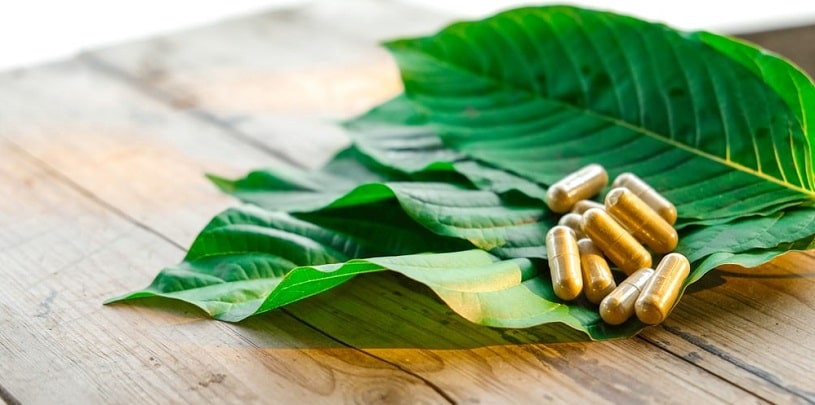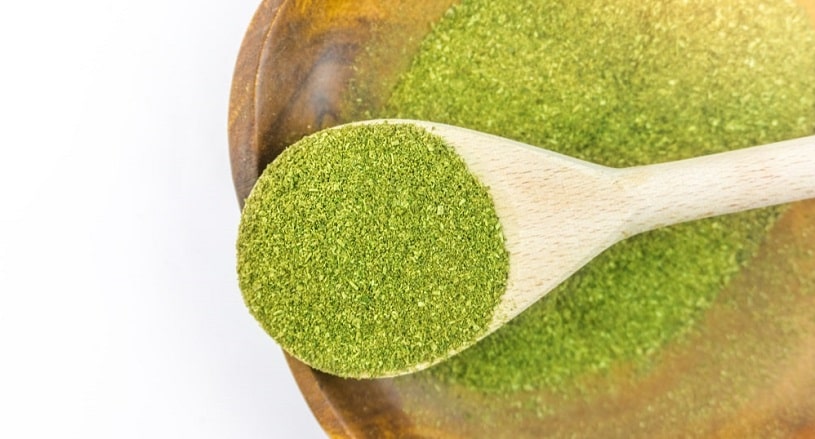Kratom, a tree originating from Southeast Asia, has been used for hundreds of years to treat different health conditions in socio-religious ceremonies and improve work productivity and fight fatigue. Today, it can be found as a Kratom supplement for the treatment of digestive issues, chronic pain and to help those dealing with opiate withdrawal symptoms. However, the Kratom addictive potential is significant due to its opioid-like effects. This may lead to abuse, tolerance, eventual dependence, withdrawal symptoms upon discontinuing the drug, which are all signs of Kratom addiction.
Table Of Contents:
What Is Kratom?
Also known as Mitragyna speciosa, this plant belongs to the Rubiaceae family, and it is a tree with origins in Southeast Asia. The tree can reach 16 meters, and its leaves have medicinal and recreational properties. However, the DEA has listed it as a drug of concern being illegal in some US states, and the FDA has not approved the herb for any medical care.

Because the legality is still uncertain in many US states, it can be bought online or on the streets as a Kratom supplement. It can be found as powdered or crushed dried leaves, a dark green or beige-brown color, and pure herb or mixed with other extracts to potentiate the effects. The plant is available as capsules, tinctures, powder, or extracts in the form of a paste.
Though some individuals claim that the herb can be used as a herbal alternative for the treatment of withdrawal symptoms and cravings, there is no scientific evidence backing these health claims, and self-medication using the herb is potentially harmful due to the risk of Kratom addiction. Some people also consume the plant in the form of a Kratom supplement due to several unfounded benefits associated with the herb.
Mitragyna Speciosa Active Ingredients
Pharmacology studies show that Mitragyna speciosa has more than 40 alkaloids. Still, the only alkaloids responsible for this plant’s opioid-like effects and which contribute significantly to the development of Kratom addiction are mitragynine and 7-hydroxymitragynine, which lie at the center of its actions.
Animal studies have demonstrated that mitragynine has an activity similar to an opioid. It inhibits electrically stimulated ileum, resulting in reduced pain response. It also promotes smooth muscle contraction and inhibits gastric secretion. Mitragynine is mainly found in the leaves. Mitragynine also has analgesic effects, thanks to its opioid agonist properties. At low doses, the alkaloid is relatively safe, but at higher doses, it becomes toxic. Unfortunately, it is impossible to precisely define the dose threshold for an overdose.

7-Hydroxymitragynine is the second most active alkaloid, primarily found in the leaves but in minimal amounts. This alkaloid has potent antinociceptive activity, being a significant contributor to the plant’s analgesic properties. At the average levels found in the leaves, 7-Hydroxymitragynine does not imply any danger, but at high doses, it has opiate-like effects that could lead to life-threatening risks. Studies also found that this alkaloid is more potent than morphine due to its capacity to go through the blood-brain barrier.
These alkaloids in the herb act on the mu, delta, and kappa receptors in the body. Therefore, they are used in the care of many conditions. Care should be taken to note that these alkaloids can be detected in urine or blood Kratom drug tests.
What Is Kratom Used For?
For those wondering, “what is Kratom used for?”, there are currently no medicinal uses for the herb in the US. However, people use it in daily life to manage pain in various health conditions and increase productivity because of compounds known as alkaloids present in the leaves. Usage of the herb causes psychotropic effects similar to opioids and stimulants, leading to Kratom addiction.
Regardless of FDA Warnings, People Continue to Use Different Strains of the Herb for the Following Purposes:
- pain relief
- anxiety and depression
- opiate withdrawal
- ADHD
- sleeping problems (insomnia)
- weight loss
- hangover
- migraines and headaches, etc.
Kratom For Pain
The survey showed that Kratom for pain management is widely used among middle-aged, middle-income people from the United States that had fibromyalgia, chronic pain, and cancer-related pain. Components existed in the leaves interact with opioid receptors and reduce ache perception. The herb can help to overcome the opioid crisis and relieve hurting feelings.
Kratom For Anxiety & Depression
The 2017 review found that the plant can improve mood, deal with depression, and relieve anxiety, including social anxiety, causing sedative effects. Using the herb for anxiety can manage the disturbance and spontaneous waves of anger.
There are no standardized and regulated doses, qualities, and effectiveness from the drug consumption, and the characteristics of the product can differ from vendor to vendor.
That is why it is essential to check the information and consult with respective specialists.
Kratom For Opiate Withdrawal
The report shows that using the herb for opiate withdrawal can be an effective treatment and can ease the withdrawal symptoms. Still, it could lead to misuse, dependence, and Kratom addiction in the long term. The patient in the research did not receive any adverse effects. However, in 2017, the United States Food and Drug Administration (FDA), a pharmaceutical regulatory center of the United States, issued the advisory and highlighted 36 deaths from products related to the herb. When deciding whether to consume the herb, it is better to familiarize oneself with all current information to prevent unwelcome consequences.
Kratom For Sleep
Although the availability and number of research on the substance are limited, there is some evidence from Kratom drug users that specific leaf strains can help with sleep disorders and provide a relaxing effect.

On the other hand, the substance has a stimulant effect that can lead to extra alertness and energy, including problems with falling and staying asleep. In some cases, people who use the plant for insomnia regularly may suffer from Kratom withdrawal symptoms such as nervousness, muscle pain, depression, and shaking.
Mitragyna Speciosa Abuse
Because national drug abuse surveys seldom monitor this drug, there is little information on its abuse. However, the plant has a higher potential for abuse than most individuals realize for several reasons.
Firstly, it is considered a “soft” drug, similar to alcohol or cannabis. Many individuals believe it is less harmful and addictive than other illicit drugs such as opioids and cocaine. This prompts them to take the agent at much higher doses and more frequently than they usually would. Research between 2011-2017 showed an increasing trend in use among Americans, with as many as 3-5 million estimated users. During the investigation, as many as 1,807 calls reported exposure to the plant during that period.
Another factor that enhances the abuse potential of the Kratom drug is the unfounded belief that it can help “ease” the symptoms of withdrawal from other illicit drugs. However, this is simply due to the user feeling the opioid-like effects caused by the plant within the brain, prompting further use and potential Kratom addiction.
The last issue is that to achieve the desired effects, one needs to consume the plant in large quantities. It prompts users to take unsafe amounts of the Kratom drug or even combine it with other psychoactive substances, further increasing the danger of adverse effects and even a potential Kratom overdose.
A 2019 study found that over 81% of deaths involving the plant between 2011-2017 involved the use of the plant with other illicit drugs and substances such as alcohol.
Kratom Tolerance
Kratom tolerance often appears over a long period of use. Kratom tolerance settles in when the current dose starts to slowly lose its potency until it no longer offers the expected Kratom drug effects. Kratom tolerance occurs when the affinity of its active agents with the receptors decreases, but it could also happen when the liver enzymes metabolize the active agents faster.
The developed tolerance forces an individual to increase the dosage to achieve the same results as before, risking an overdose, serious health issues, and addiction. To avoid this, many people try to lower drug tolerance by potentiating the herb.
Is Kratom Addictive?
Contrary to popular belief, the plant is quite addictive. It activates opioid-receptors within the brain through the action of several active agents, leading to opioid-like effects such as euphoria, sensory desensitization, and sedative effects.

Chronic use leads to changes in brain chemistry and receptor concentrations, requiring higher doses to achieve the same effects. This is referred to as tolerance.
As subsequently higher doses of the drug are required to achieve the same effects, the drug user eventually reaches a point where they require the drug to prevent the unpleasant physical and psychological withdrawal symptoms which occur when the drug is not taken for a prolonged period. This is known as dependence.
This cycle eventually ends at the point of drug addiction, a state in which an individual cannot resist the urge to consume a particular substance, despite the physical, psychological, or social harm it causes them.
A good example of the Kratom addictive potential is highlighted in a study that monitored the long-term effects of a subject who used the plant consistently for over four years. The drug was initially used alongside opioids, but later, upon quitting opioids, the subject used the agent as an alternative treatment of the adverse symptoms of opioid withdrawal. Upon cessation of the herb, the subject noticed withdrawal symptoms that were less severe yet more protracted than that of opioid withdrawal and which necessitated medical treatment.
Kratom Addiction Signs and Symptoms
There are several signs and symptoms which may accompany Kratom addiction.
Some Important Signs and Symptoms Include:
- Regular, nearly constant craving for the drug
- Inability to focus or impaired cognition due to intense craving for the drug
- Taking higher quantities of the substance than initially intended or taking it for more extended periods than intended
- Requiring steadily increasing doses of the drug to achieve the desired effects
- Drug-seeking behaviors
- Purchasing the medication even at the expense of your finances
- Resorting to dangerous and even criminal activities to obtain the drug or money for the drug
- Participating in risky behaviors such as unprotected sex or driving while on the drug or alcohol
- Increased abuse of other substances such as opioids, alcohol, or stimulants, especially while on the drug
- Trying and failing multiple times to quit the drug
- Continued use of the herb despite the harm its use has caused to yourself or those around you
- Experiencing withdrawal symptoms upon cessation of the drug
Kratom Addiction Treatment
Kratom addiction treatment takes place in three phases: physically stabilizing the user, therapy, and recovery. Physical stabilization implies detox, which is performed in a specialized center, where the individual benefits from medical surveillance and medications. The treatment and counseling will be offered either in a residential or outpatient setting, depending on each individual and their physical detox results. Addiction treatment in such a center ensures long-lasting recovery.

There are also Kratom alternatives that one can try to avoid the addiction issue. Some of them include OTC medications or herbal supplements with fewer side effects and no addiction potential.
Between Good And Bad
Although there are pros and cons of using the substance, having a final report from the DEA is critical. While there are no approved medicinal uses of the plant, the legal status of Mitragyna speciosa makes this drug dangerous for the users. Self-medication poses numerous risks. To prevent developing an addiction or any other side effects, it is best to abstain from using such remedies and consult a doctor.
Those who have already developed an addiction to the substance or notice abuse signs should know that numerous drug rehab centers specialize in drug abuse and addiction and have recovery specialists who can help. A trusted addiction professional will offer the path towards recovery and a life free of addiction.
Frequently Asked Questions
Is Kratom an Opioid?
Current research has shown key similarities between the active agents found in Mitragyna speciosa and classical opioids such as morphine. Although it is not considered an opioid, the FDA has stated the opposite. The FDA classifies it as an opioid.
What is Kratom Powder?
This is a powdered form of the psychoactive herb. It is illegal in most parts of the United States and several other countries, but it can be purchased online through various vendors due to poor awareness and weak enforcement. Some individuals brew it as a form of teas, while others consume the powder.
Where is Kratom Grown?
The plant is native to Southeast Asia and is indigenous to several countries such as Thailand, Indonesia, Malaysia, Myanmar, and Papua New Guinea. However, the plant can be grown in most tropical climates.
Is Kratom Safe to Take Every Day?
The safety of the plant has not been demonstrated at any dose or dosage schedule. Current evidence points to several crucial adverse health effects associated with the prolonged use of the herb. Therefore the plant is most likely not safe to take daily, even at low doses.
Hope Without Commitment
Find the best treatment options. Call our free and confidential helpline
Most private insurances accepted
Page Sources
- National Institute on Drug Abuse, Kratom Drug Facts, 2019. https://www.drugabuse.gov/publications/drugfacts/kratom
- Olsen, E. O., O'Donnell, J., Mattson, C. L., Schier, J. G., & Wilson, N. (2019). Notes from the Field: Unintentional Drug Overdose Deaths with Kratom Detected - 27 States, July 2016-December 2017. MMWR. Morbidity and mortality weekly report, 68(14), 326–327. https://doi.org/10.15585/mmwr.mm6814a2 https://www.ncbi.nlm.nih.gov/pmc/articles/PMC6459583/
- Veltri, C., & Grundmann, O. (2019). Current perspectives on the impact of Kratom use. Substance abuse and rehabilitation, 10, 23–31. https://doi.org/10.2147/SAR.S164261 https://www.ncbi.nlm.nih.gov/pmc/articles/PMC6612999/
- Boyer, E. W., Babu, K. M., Adkins, J. E., McCurdy, C. R., & Halpern, J. H. (2008). Self-treatment of opioid withdrawal using kratom (Mitragynia speciosa korth). Addiction (Abingdon, England), 103(6), 1048–1050. https://doi.org/10.1111/j.1360-0443.2008.02209.x https://www.ncbi.nlm.nih.gov/pmc/articles/PMC3670991/
- Yusoff, N. H., Suhaimi, F. W., Vadivelu, R. K., Hassan, Z., Rümler, A., Rotter, A., Amato, D., Dringenberg, H. C., Mansor, S. M., Navaratnam, V., & Müller, C. P. (2016). Abuse potential and adverse cognitive effects of mitragynine (kratom). Addiction biology, 21(1), 98–110. https://www.ncbi.nlm.nih.gov/pubmed/25262913
- Fluyau, D., & Revadigar, N. (2017). Biochemical Benefits, Diagnosis, and Clinical Risks Evaluation of Kratom. Frontiers in psychiatry, 8, 62. https://doi.org/10.3389/fpsyt.2017.00062 https://www.ncbi.nlm.nih.gov/pmc/articles/PMC5402527/
- U.S. Food and Drug Administration, Statement from FDA Commissioner Scott Gottlieb, M.D., on the agency’s scientific evidence on the presence of opioid compounds in kratom, underscoring its potential for abuse, 2018. https://www.fda.gov/news-events/press-announcements/statement-fda-commissioner-scott-gottlieb-md-agencys-scientific-evidence-presence-opioid-compounds
- U.S. Food and Drug Administration, Statement from FDA Commissioner Scott Gottlieb, M.D. on FDA advisory about deadly risks associated with kratom, 2017. https://www.fda.gov/news-events/press-announcements/statement-fda-commissioner-scott-gottlieb-md-fda-advisory-about-deadly-risks-associated-kratom





